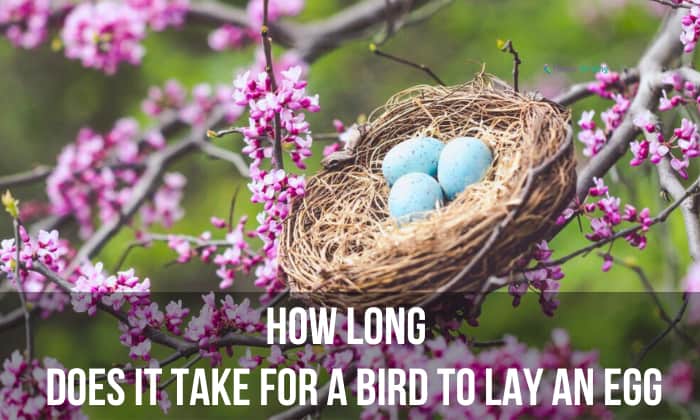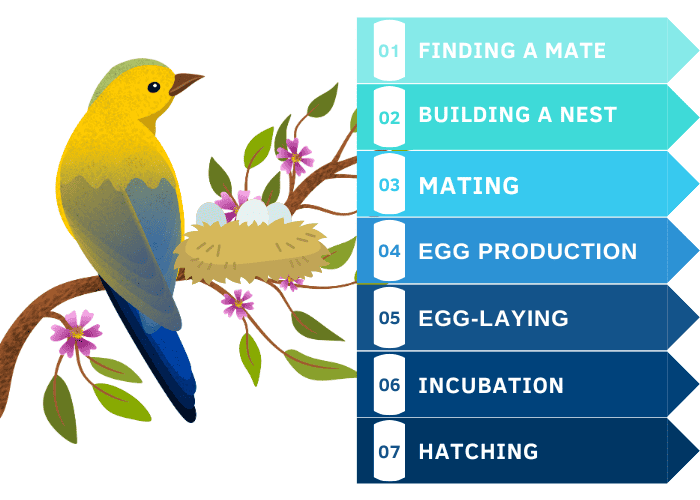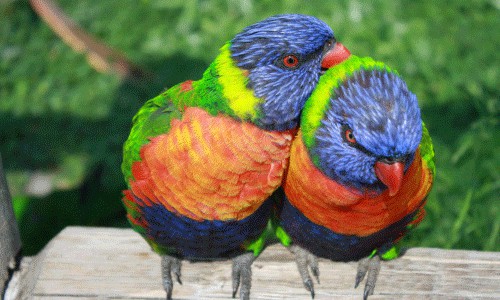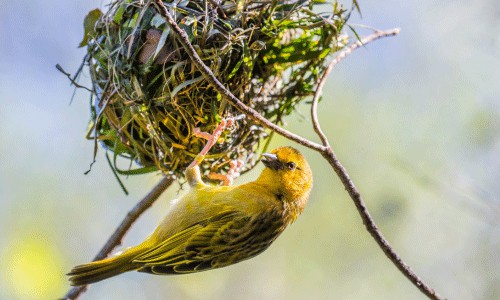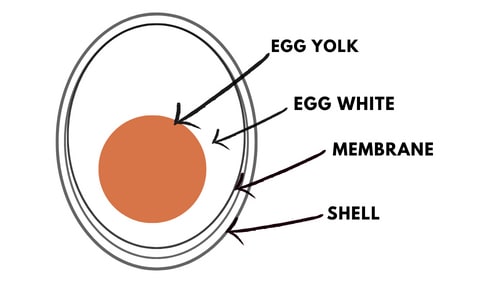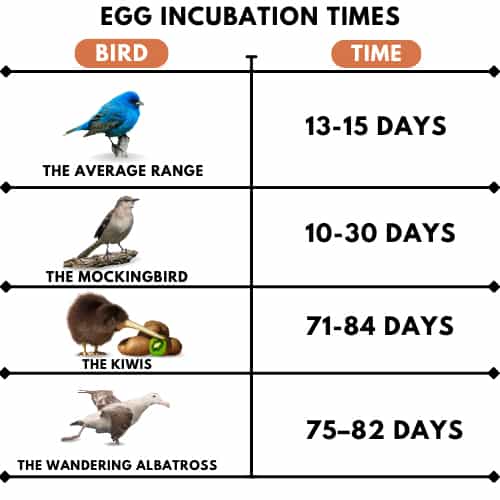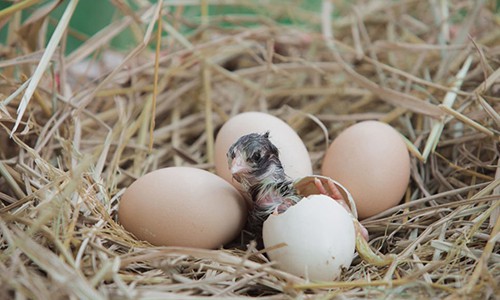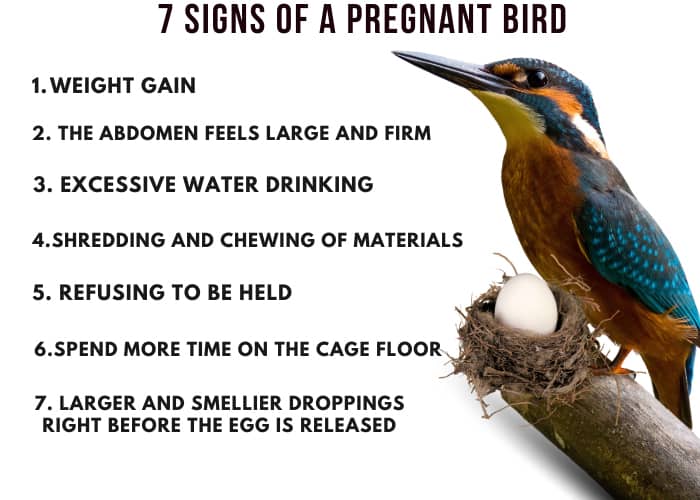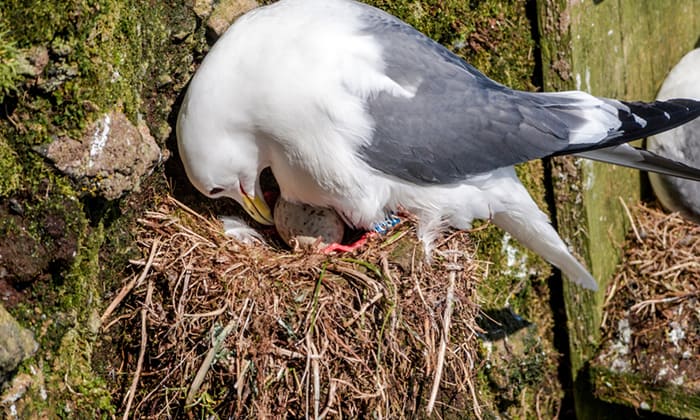It’s springtime! The bees are buzzing, the flowers are blooming, and the birds are busily building their nests and laying eggs.
“How long does it take for a bird to lay an egg?” You wonder.
Most birds take 1–2 days to lay an egg but need to spend the next 10–30 days incubating it, with the exact number depending on the species. However, that’s only part of the story. The bird egg-laying process begins with finding a mate and ends with feeding small, hungry mouths.
Curious? Read on to learn all about a bird’s entire nesting cycle!
Table of Contents
The Egg-laying Process (Nesting Cycle)
Birds go through an entire process to lay eggs and produce young. During this time, these species are more aggressive and territorial. They may even flock in large colonies during nestling to protect their young.
Here is a quick overview of birds’ nesting cycles and the egg-laying process.
1. Finding a Mate
When do birds lay eggs? Most begin finding a potential mate to build a family within the spring, though some species do so at other times of the year—one example is the crossbill which ovulates in January.
Few birds are monogamous, though. It is common for males to have many partners within a single breeding season, and females of some species have the same practice.
2. Building a Nest
Once a mate has been found, it’s time for birds to build a place to store their eggs.
While many birds build the traditional nest in tree branches, some build nests on the ground, while others forego nests and dig up small ditches instead.
Females of birds laying eggs in nest species typically build the nests, but they can also be made by the male or the couple working together. In any case, this process should take about 3 weeks.
3. Mating
Reproductively speaking, male and female birds look the same on the outside. This is because most avian species keep their sex organs internally inside a chamber called a cloaca.
Even if you don’t see them, they are definitely present. A male bird’s testicles can swell up to 1,000 times their average size during mating season!
During copulation, a male injects his sperm into the female to fertilize the growing eggs inside her oviduct.
4. Egg Production
How does an egg develop inside a bird?
It begins with the egg being released from the bird’s ovary and sent through the oviduct.
The egg’s journey through the oviduct is critical because this is where the egg is “assembled.” The egg will receive the following in the listed order:
- A layer of egg yolk, which will become the chick’s food source
- A layer of albumen, or “egg white,” acts as protection for the egg
- An outer protective membrane
- The outer shell
The hard outer shell is added when the egg has reached the uterus, just before the egg enters the cloaca and leaves the bird’s body.
On average, this process should take 1–2 days. At the faster end of the spectrum, chickens typically only need 24–25 hours to produce eggs. However, the longest egg-producing time can be up to 48–50 hours, as observed in bald eagles.
5. Egg-Laying
While mating is a pre-requisite to having chicks, it does not guarantee that the female will lay eggs afterward or that her eggs will be fertile.
That being said, the egg-laying schedule of females greatly varies per species. How long is a bird pregnant before laying eggs? To be clear, birds don’t get pregnant after mating in the same way mammals do. Once the egg is formed, they will lay it.
Eggs are laid in batches called clutches, whose size varies per species. Generally, most birds lay one egg every day or two until they complete their clutch.
If a female bird fails to lay all her eggs and a few get stuck inside her, she becomes “egg-bound.” These birds need treatment within a few days to survive.
6. Incubation
This process is usually done by female birds, although some species do practice biparental incubation, such as the Emperor penguin or African common waxbill.
As always, each species has its incubation style, although the average range is 10 to 30 days. Generally, smaller birds hatch quicker than bigger birds.
To name an example, small perching birds, such as the mockingbird, incubate their eggs for 13 to 15 days. House sparrows and European Starling also only take 11 to 14 days to incubate, if not fewer.
In contrast, big birds tend to spend more time incubating. To date, the one holding the record for the longest incubation is the kiwis for an average of 71-84 days, followed by the wandering albatross for 75–82 days.
Some species, such as herons, cranes, and raptors, begin incubating when the first egg is laid, resulting in their chicks hatching on different days.
7. Hatching
Finally, the long-awaited day comes, and the parents can welcome their babies into the world.
Species with shorter incubation periods tend to be born blind, featherless, and cannot control their own body temperature for the first week of their lives.
Conversely, birds with longer incubation time have more time to develop and emerge from their eggs fully feathered, with their eyes open, and already mobile.
Factors That Affect the Egg-laying Process
The most crucial factor in the egg-laying process is day length, which birds rely on to identify the season and what time of year it is.
Extended periods of sunlight and warmer temperatures in spring signal most birds that it’s time to begin their nesting cycle.
Since captive birds are not often exposed to the natural elements, they usually miss this step, and pet birds carry eggs anytime throughout the year.
Aside from day length, a few other factors come into play during this season, including food/water availability, latitude, female age, mental state, weather, and time of year.
How Do You Know if a Bird is Going to Lay Eggs?
Female birds act a little differently when getting ready to lay eggs. Here are some signs of bird pregnancy.
- Weight gain
- The abdomen feels large and firm
- Excessive water drinking
- Typical nesting behaviour in birds, such as shredding and chewing of materials, as if preparing to build a nest
- Refusing to be held or backing away from you
- Spending more time on the floor of the cage instead of on perches
- Larger and smellier droppings right before the egg is released
Common Birds and Their Egg-laying Times
|
Bird |
Clutch Size |
Incubation Period |
|
Budgerigars |
4-8 eggs |
18 days but never more than 23 |
|
Cockatoos |
2-3 eggs, but sometimes as many as 8 |
Average of 24-30 days, but varies per species |
|
American Robin |
3-4 eggs, rarely 5 |
12-14 days |
|
Mourning Dove |
2 eggs |
14 days |
|
House Sparrow |
1-8, usually 5 |
11–14 days |
|
Hummingbirds |
2 eggs |
10-14 days |
|
Finch |
3-6 eggs |
12-17 days |
|
Bald Eagle |
2-4 eggs |
40 days |
Note that the clutch size is not necessarily a bird’s brood size. It is very rare for all eggs in a clutch to hatch, and perfectly normal bird behavior for birds nesting now to throw out eggs it knows will not hatch.
Frequently Asked Questions
What age do birds start laying eggs?
Birds typically start laying eggs between 5 months to 10 years of age. For instance, chickens are known to begin as early as 18 months!
How many eggs do birds lay in one lifetime?
It’s difficult to count how many eggs a bird lays in one lifetime since there are many factors, from the availability of a mate to the female’s access to food to even climate change.
Females also tend to lay larger clutches when younger, with the number of eggs per clutch decreasing as they age.
Taking a common example, though, let’s look at the chicken for fascinating bird egg facts.
A healthy chicken will produce 200-250 eggs in their first year of egg laying, decreasing by 10-20% each succeeding year. They also spend six to seven years laying eggs.
Considering those factors, average chickens are estimated to lay 600 eggs in their lifetime.
How long do bird eggs take to hatch?
Bird eggs can take anywhere from 10-30 days to hatch.
Generally, smaller birds, like songbirds, take ten days, while larger birds, such as eagles, take 30 days or more.
The incubation length affects the development of the chick. Once again, birds with longer incubation periods come out stronger and more mature than those with a shorter time in their eggs.
Can a bird lay eggs without a male?
Female birds can lay eggs without a male present. However, unless the bird had contact with a male before laying, the egg will be infertile and not hatch.
Bird eggs are fertilized internally before being laid, so contact with a male after laying will not make a difference to the current batch of eggs.
Conclusion
There is no one answer for how long does it take for a bird to lay an egg. Each species follows its timeline, and avians rely on many external environmental factors to lay fertile, healthy eggs.
Also, even if the eggs successfully hatch, most chicks don’t make it past their first year of life in the wild.
Therefore, consider helping your garden birds by setting up nest boxes, bird baths, and feeders. Aside from improving their chances of survival, you’ll make many feathery friends in the process!

George and I became friends after a birdwatching trip with our new group. And we have been enjoying every adventure together. When he told me the idea of establishing a site that shares our experiences and fun, I immediately agreed. After trials and errors, here we have Thayerbirding.


